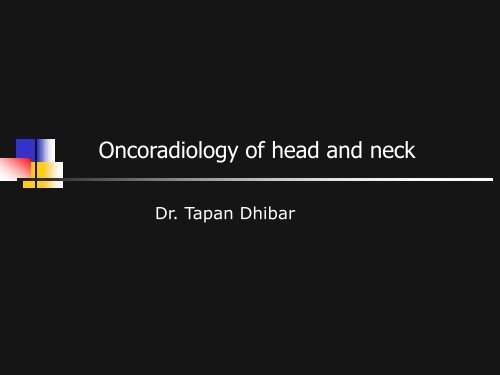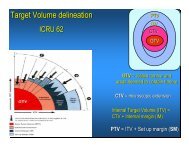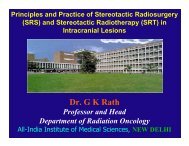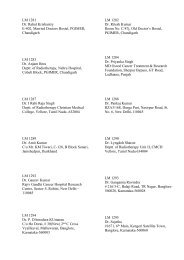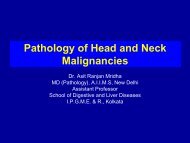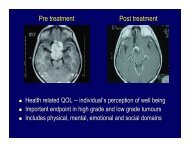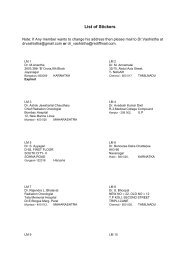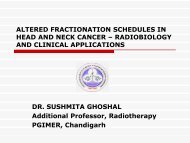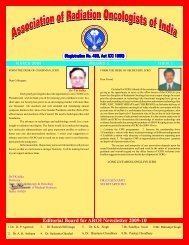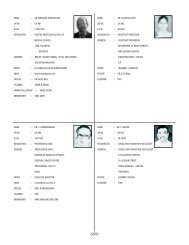Dr. Tapan Dhibar Oncoradiology Of Head And Neck - Aroi.org
Dr. Tapan Dhibar Oncoradiology Of Head And Neck - Aroi.org
Dr. Tapan Dhibar Oncoradiology Of Head And Neck - Aroi.org
Create successful ePaper yourself
Turn your PDF publications into a flip-book with our unique Google optimized e-Paper software.
<strong>Oncoradiology</strong> of head and neck<strong>Dr</strong>. <strong>Tapan</strong> <strong>Dhibar</strong>
Modalities• X-ray• Limited use in staging• Useful in planning for radiotherapy• Ba-swallow is useful in early phase of pharyngealsurgery to access for fistula formation and toaccess functional disorders• USG• With FNAC is comparable with CT for neck nodalstaging
Adamantinoma
Histiocytosis X
Multiple myeloma
• CT/MRI• Both are equally good in head and neck• Choice of modality depends on the patient andpathology• Generally MDCT is preferred over MRI
• PET-CT• Upcoming modality for functional imaging
CT tech. - <strong>Neck</strong>• For axial scanning pt supine, quiet respiration, neck in slightextension• From upper border of sphenoid sinus to lower border ofsternoclavicular joints, craniocaudally• FOV as small as possible• 3mm slice thickness for neck, 2mm for facial bones and sinonasalcavities. For single slice scanners - pitch of 1-1.6• Contrast• 100cc for MDCT scanners, 2.5cc/s first 45-50ml. Rest - 1cc/s,scanning to begin 25s after the administration• Upto 150cc for single slice scanners, 1cc/s, 60s scan delay• Non-ionic contrast is preferred
tech…• Gantry tilt• Not required forMDCT• For single slicemachines, parallel tohard palate upto theoral cavity, paralledto the vocal cords orIV discs of C4-C5 orC5-C6 vertebraebelow
tech…• Direct coronal scan - neck extended, gantry perpendicular to hard palate• 3D reconstructions are useful• Dynamic maneuvers - modified valsalva or phonation to distend pyriform sinuses• <strong>Neck</strong> to be shifted to the opposite side for opening up of pyriform sinuses
MRI• Coils• <strong>Head</strong> coil – upto hyoid bone, below - neck coil• Pulse sequences• TSE T2, T1, FLAIR, STIR/Fat Sat, Post contrast,DWI. Most important is T1 and T1+C• Slice thickness 3-4mm, interslice gap of 0-50%• Matrix - at least 256*256. For lesions aroundskull base and sino-nasal cavities 512*512• MRS is upcoming
<strong>Neck</strong> spaces
Nodal staging for head and neck
Glottic SCC
Supra-glottic SCC
Sub-glottic SCC
Metastasis
Hypopharynx and proximaloesophagusRt Pyriform sinus tumor
Upper oesophageal Ca
Oral cavity, Sublingual andSubmandibular space
Epidermoid
Oropharynx
Rt tonsillar Ca
Left tongue base Ca
NasopharynxRt fossa of rosenmuller tumor
TNM staging
Parapharyngeal space
Prestyloid compartment - Pleomorphic adenoma
Post-styloid compartment - schwannoma
B/L Post-styloid compartment - paraganglioma
Deep mandibular lesion extending to PPSRhabdomyosarcoma
Masticator space
Lt masticator space lesionRhabdomyosarcoma
Osteosarcoma
Sino-nasal cavitiesSCC
SCC of Rt maxillary sinus
Esthesioneuroblastoma
Nasal Adenocystic ca
Inverted papilloma
Metastasis
Meningioma
Hemangioma
NHL
Parotid gland (Parotid space)
Pleomorphic adenoma
Warthin’s tumor
Hemangioma
Left parotid lipoma
Adenocarcinoma
Mucoepidermoid tumor of minor salivary gland
Thyroid & parathyroid(visceral space)Papillary carcinomawith lymph node metastasis
Anaplastic carcinoma
Parathyroid adenoma
<strong>Neck</strong> nodes<strong>Neck</strong> nodes - Levels
contd…Level IAbove - mylohyoidBelow - hyoidanterior to a line drawn connecting posterior edge of submandibular glandIA - Between mylohyoid musclesIB - Lateral to mylohyoid musclesLevel IIAbove - skull base, at the lower level of the bony margin of the jugular fossaBelow-lower margin of the body of the hyoid bonePosterior-anterior to a transverse line connecting the posterior edge of thesternocleidomastoid musclesAnterior-posterior to a transverse line connecting the posterior edge of thesubmandibular glands
Level IIA nodes are situated anterior, medial or lateral to the internal jugular vein.These also define Level II lymph nodes that are posterior to the internal jugularvein but directly abut the vein whereas Level IIB nodes are posterior to theinternal jugular vein and have an identifiable fat plane between the lymph nodeand the veinLevel IIIAbove - Hyoid boneBelow - Cricoid cartilagePosterior - anterior to a line connecting the posterior margins of the SCM muscleand lateral to medial margin of either the common carotid artery or the internalcarotid arteryLevel IVAbove - Cricoid cartilageBelow - ClaviclePosterior - anterior and medial to an oblique line drawn connecting the posterioredge of the sternocleidomastoid muscle and the posterolateral edge of the anteriorscalene muscle and lateral to the carotid artery
Level VAbove - Skull baseBelow - ClavicleAnterior - Posterior edge of SCM musclePosterior - anterior to trapeziusLevel VA nodes lie between the skull base and the level of the lowermargin of the cricoid cartilage archLevel VB nodes are located between the lower margin of the cricoidcartilage and the clavicleLevel VIAbove - Hyoid boneBelow - Upper part of sternumBetween - the medial margins of the left and right common or internalcarotid arteriesLevel VIILie caudal to the top of the manubrium, between the medial margins ofthe left and right common carotid arteries, and extend caudally to thelevel of the innominate vein
PET-CT
Metastasis (RCC)
Thank You


